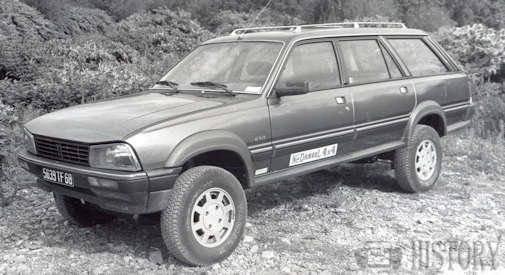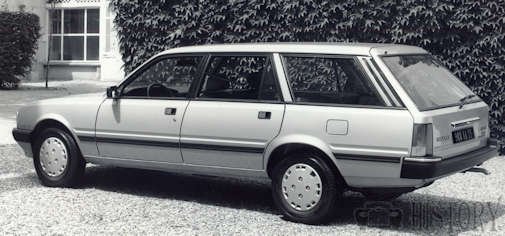Peugeot 505 car history
 |
|
|---|---|
| Technical details | |
| Manufacturer | Peugeot |
| Production | 1979 to 1997 |
| Class | Motor car |
| Drive | Rear wheel-drive, 4 wheel drive |
| Designer | Pininfarina |
| Total production | 1,351,254 |
| Body and chassis | |
| Body styles | 4 door Sedan, estate |
| Engine and Powertrain | |
| Engine Petrol | 1.8 to 2.8 |
| Engine Diesel | 2.3 to 2.5 litre |
| Engine location | Front-engine |
| Cooling | Water cooled |
| Weights and Dimensions | |
| Wheelbase | 2743-2900 mm |
| Length | 4,580 mm to 4,900 mm |
| Width | 1730 mm |
| Height | 1 450 mm to 1 540 mm |
| Curb weight | 1,200 to 1,415 kg |
The Peugeot 505 is a car of the Peugeot brand produced between May 1979 and June 1992. Its exterior design is the work of Pininfarina and the interior design is the work of Paul Bracq .For the body, the design of Pininfarina prevailed at the time in the competition against the Peugeot design department. Pininfarina shaped the 505 edgy and conservative, as he had already designed the 504. After the cessation of production in Europe, the Chinese company Guangzhou Peugeot Automobile Company built the model for the local market until the year 1997 under the name Guangzhou-Peugeot GP 7202.
History
The vehicle was initially offered only as a four-door notchback sedan . In April 1982, the combi version Break appeared , which came up with up to eight seats ( Familial ). Like the Citroën CX Familiale , the Peugeot 505 Familial had a third seat in the direction of travel - at that time the only European station wagon with eight seats.Two body styles realized only as prototypes (coupe and convertible) are owned by the Museu de l'Aventure Peugeot in Sochaux (France).
Drive and chassis of the 505 were largely taken over from the predecessor. The engine was longitudinally mounted front and drove the rear wheels. The front wheels were individually suspended on MacPherson struts and wishbones , rear there were in the station wagons and the built in Argentina sedans a rigid axle with drawbar and Panhardstab or semi - trailing arms in all others.
From the 505 two series were successively manufactured: These differed externally slightly by modified tail lights , bumpers and front aprons .The model was in addition to the published in the autumn of 1987 Peugeot 405, the last Peugeot, which was also sold in the US - but there with modest success.
The Peugeot 505 was also the last rear-wheel-drive Peugeot and the last with the brand face of the 1960s (forward sloping front, headlamps with "eye-opener"). A new brand face was introduced in the summer of 1983 with the Peugeot 205 .
Large sedan of the Peugeot range, the 505 is the successor to the 504 which has been a great commercial success and which it shares the chassis. The 505 was launched in 1979 after the 305 of 1977. The 505 was the last sedan of the brand propulsion . The 505 has existed with gasoline or diesel engines , sedan or station wagon (finish Break or Familial 8 seats), the latter served as a basis to be transformed into an ambulance, 4 × 4 ( Dangel versions from 1986) or in double cabin pickup ( Oatmeal ). Coupe and cabriolet versions remained in prototype status due to the economic crisis and the withdrawal of Peugeot from the USA .

The 505 is known for being a reliable vehicle, some of which have exceeded 500,000 km In 1980, Peugeot sold 1,200 taxis to New York City and Los Angeles before it was nearly impossible to export diesel vehicles to the US. After experiencing a sales peak in 1984 (20,000 copies) and being relegated to the last rank of a series of shock tests in 1989, sales of 505 eroded in the US. Finally, Peugeot retired from North America in 1991.
In 1983, Peugeot appealed to Porsche to prepare a turbo petrol version from the 2.2 liter Chrysler-Simca block mounted on Talbot Tagora and Talbot-Matra Murena (N9T engine). The 505 Turbo Injection was recognizable by its specific two-tone paint and like-style rims as those of the 604 STI and 504 V6 coupe . First marketed in 150 hp version (which was very fuel-efficient), it was followed by a 160 hp version more economical because equipped with a heat exchanger and for which a kit PTS (Peugeot-Talbot Sport) was available. It allowed the2.2 liters to develop 200 hp . This kit was prepared by Danielson and required a complementary mention of Mines. This kit was installed by the local dealers, hence sometimes a setting difficult to find depending on the local competence of the mechanics.
In July 1985, all 505s received a new dashboard in a more massive style, a redesigned front grille, integrated bumpers and 309- style taillights on sedans. In 1986, the engine of the 505 Turbo Injection rose to 180 hp . The V6 and V6 S versions equipped with the V6 PRV with staggered crank pins prepared the arrival of the 605 V6 as a test for the implementation of this engine.In the revision in August 1985, which included a modified rear end (wider taillights in the style similar to those of the 309 ) and an attached spoiler edge,
With the simultaneous production adjustment of the larger 604 , the 505 should also take the role as a model of the upper middle class at Peugeot. Therefore, the smaller engine variants were eliminated, and with the introduction of the Peugeot 405 in October 1987, the equipment variants of the 505 were gradually reduced, since it should from now on apply as a model of the upper middle class, while the 405 was intended for the middle class.
In 1986, the 505 V6 had ABS , central locking of remote doors, four electric windows, electric sliding sunroof, electric and defrost mirrors and a cruise control (if automatic transmission).
The STi model won the Rally Tour d'Europe reserved for cars strictly in production in 1981 with the crew Holger Bohne / Peter Diekmann His career in France ended on March 10, 1992 after 1,337,700 models produced.
The Peugeot 505 is built on the platform of its predecessor, the 504 , which it takes the engines on the first versions with carburettor (GR, SR) and diesel (GRD, SRD). On the other hand, on injection versions (TI, STI), the all-alloy 2- liter engine (" Douvrin engine ") produced by the French Mechanics company in Douvrin (a PSA / Renault joint venture ), which is also mounted on the Renault 20 TS, is new. The 505 Turbo Injection will use a more rigid cast iron Chrysler engine for supercharging.
During the construction period, various engines were offered. There were four-cylinder gasoline and diesel engines with and without turbocharger, which were initially unchanged from the predecessor models 504 and 604 (Turbo Diesel) were taken. The 1983 offered four-cylinder turbo engine is based on the developed by Simca 2.2-liter engine of the Talbot Tagora .
The gasoline engines were available on the one hand as carburetor versions, on the other hand, first with mechanical and later with electronic injection. Furthermore, after setting the Peugeot 604 of the Peugeot 505 was offered with a six-cylinder engine with 2849 cc and 125 kW (170 hp) (V6).
The offered engine power varied between 51 kW (69 hp) for the 505 GL Diesel with 2498 cc of displacement and a maximum of 128 kW (174 hp) for the 505 Turbo Injection with 2128 cc displacement. The engine with the lowest engine displacement was the 1783 cc gasoline engine of the 505 GL, initially with 60 kW (82 hp). The strongest turbodiesel with intercooled air cooled 77 kW (105 hp).

Technical
-
Peugeot 505 engines (1979-1997)
gasoline
- XM7 1.8 l 82 hp: GL Break (Model Year 1982-83)
- XM7A 1.8 l 90 hp: sedan GL, GR and SX, from the restyling of 1985 (AM 1986-91)
- XN1 2.0 l 96 hp: sedans GL, GR, SR (AM 1979-83), GL Break (AM 1984-85), GL Family (AM 1985), Break GR, Fam./Fam. GR (1982-85), Break SR (AM 1982-85) and Fam. SR (AM 1984-85) - 5 speed gearbox option (BV5) or automatic gearbox (BVA) -
- XN1A 2.0 l 100 hp: sedan GL, GR, SR (AM 1984-85) and SX (AM 1985) - Option BV5 or BVA -
- XN1A 2.0 l 108 hp: sedans GR, SR (AM 1986-88), ST (AM 1989), GL Break, Fam. GL (AM 1986-90), Break SX, Fam. SX (AM 1991-92), Break GR and Fam. GR (AM 1986-90) - Option BVA -
- ZEJ 2.0 l 110 hp injection: TI and STI sedans (AM 1979-81) - BVA option -
- ZDJ 2,2 l 117 hp injection: sedan STI (AM 1982-83) - Option BVA -
- ZDJ-L 2.2 l 130 hp injection: GTI sedans (AM 1984-89), GTX (special series), GTI Break and Fam. GTI (AM 1986-89) - BVA Option -
- ZN3J 2.8 l V6 170 hp injection: V6 sedans (AM 1987-89) and V6 S (AM 1988-89) - BVA option -
- N9T 2.2 L Turbo 150 hp: Turbo Injection Sedan (AM 1983-84)
- N9TE 2,2 l turbo 160 hp: Turbo Injection sedan (AM 1984-85)
- N9TEA 2.2 L Turbo PTS 200 hp: Turbo Injection Sedan (AM 1984-85)
- N9TEA 2.2 l turbo 180 hp: Turbo Injection sedan, from the restyling of 1985 (AM 1986-88).
- N9TEA 2.2 l turbo 200 hp (1989): sedan sedan US version, a few rare.
Diesel
- XD2 2.3 l 70 hp: GRD, SRD (AM 1980-81) and GLD (AM 1982-83) sedans - BVA option -
- XD3 2.5 l 76 hp: sedans GLD (AM 1983-89), SXD (AM 1985-91), GRD (AM 1982-88), SRD (AM 1982-83), Break GLD (AM 1984-90), Fam. GLD (AM 1985-90), SXD Break (AM 1991-92), Fam. SXD (AM 1991-92), GRD Break, Fam. D / Fam. GRD (AM 1982-1990), Break SRD (AM 1982-85) and Fam. SRD (AM 1984-85) - Option BV5 or BVA -
- XD2S 2.3 l turbo 80 hp: sedan SRD Turbo (AM 1981-85) - Option BVA -
- XD3T 2.5 l turbo 95 hp: SRD Turbo sedans (AM 1986-1988), STD Turbo (AM 1989), GTD Turbo (AM 1984-1986), GTD Turbo Break and Fam. GTD Turbo (AM 1986) - Option BVA (in series on Break and Fam.) -
- XD3TE 2.5 l turbo 110 hp: GTD turbo sedan (AM 1987-1989), GTD Turbo Break and Fam. GTD Turbo (AM 1987-1989) - Option BVA (in series on Break and Fam.) -
Turbo Injection Sedan Specifications
Cylinder capacity:
2 155 cm 3
Power :
180 ch
Unloaded weight :
1 345 kg
Tires :
195/60 VR 15
Performance (manufacturer data):
maximum speed: 210 km / h , 0 to 100 km / h : 8.4 s , 1,000 m standing start: 29.4 s
Consumption:
12 L / 100 km
